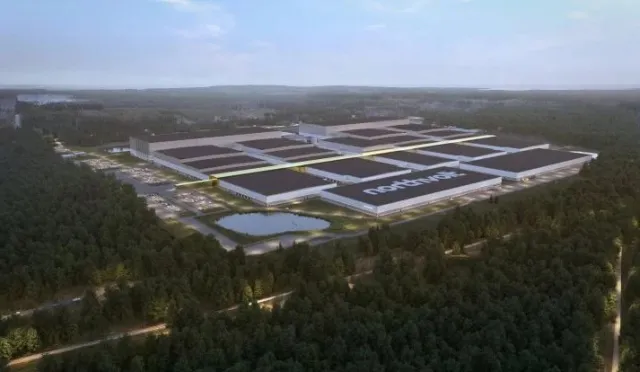Europe Set to Race Past US in Battery Manufacturing
Jul 18, 2019 01:00 PM ET
- Europe’s battery manufacturing capacity is on the cusp of dramatic growth, though much of the investment and know-how are coming from Asian companies.

A slew of recent announcements has left Europe poised to overtake North America in terms of battery manufacturing capacity by 2023, analyst figures show.
Bloomberg New Energy Finance (BNEF) expects European nameplate lithium-ion battery manufacturing capacity to top 198 gigawatt-hours a year by 2023, up from roughly 18 gigawatt-hours a year today.
This more than tenfold growth over the next few years should allow Europe to overtake North America, which is set to have around 130 gigawatt-hours a year of manufacturing capacity by 2023, according to the analyst firm.
“Europe is moving away from being a laggard to committing serious amounts of capital and state support,” said Logan Goldie-Scot, head of energy storage at BNEF.
Furthermore, Europe’s battery manufacturing growth estimate is viewed as being more reliable than North America’s because the latter is highly dependent on the fortunes of a single company, EV maker Tesla.
However, neither region will come anywhere close to matching the battery manufacturing capacity forecast for China.
Asian leaders push into Europe
China is expected to boast around 800 gigawatt-hours of annual manufacturing capacity by 2023, or two-thirds of a global total of just over 1.2 terawatt-hours, BNEF figures show.
Furthermore, much of the manufacturing capacity currently being built or planned in Europe belongs to Chinese and other Asian manufacturers.
Ningde, China-based Contemporary Amperex Technology, for example, is investing in a 14-gigawatt-hour-a-year battery factory in Germany after signing EV supply deals with German carmakers BMW and Volkswagen.
Another Chinese battery manufacturer, Svolt Energy Technology, is planning a European base with 24 gigawatt-hours of production capacity a year by 2025.
Elsewhere, South Korean manufacturers including LG Chem, Samsung SDI and SK Innovation are planning to expand their European operations.
The latest South Korean player to join the fray is automaker Inzi Controls, which this month announced $5.6 million of Hungarian government grant funding toward a $51.6 million lithium-ion battery manufacturing facility due to open in Hungary in 2020.
These companies’ aggressive investment plans have forced European Union leaders to seek ways of fostering a homegrown industry, so the continent’s auto sector does not end up being beholden to Asian battery giants.
In a report published in April, the European Commission warned: “The EU’s high dependency on battery cell imports could expose industry to high costs and risks in the supply chain and undermine the automotive industry’s ability to compete with foreign competitors.
Germany and France have led European moves to head off this threat, creating a European Battery Alliance tasked with guiding investments in the battery manufacturing value chain thought to amount to 100 billion euros ($113 billion).
This investment aims to capture a predicted 400 gigawatt-hours a year of battery demand by 2025 through the establishment of 15 to 25 lithium-ion gigafactories, although European Commission statements are vague on whether this could include Asian-owned factories.
For now, examples of made-in-Europe lithium-ion battery manufacturing prowess are still scarce.
Last month, the Swedish battery maker Northvolt declared it had completed a $1 billion equity capital raise “to enable Europe’s first homegrown gigafactories for lithium-ion batteries.”
This was followed by a €7.25 million ($8.16 million) investment from EIT InnoEnergy, an investment vehicle supported by the European Institute of Innovation and Technology, toward a 32-gigawatt-hour-a-year production facility planned by the company Freyr in Norway.
Nevertheless, even the Northvolt investment “doesn’t add up to a huge amount of capacity in the grand scheme of things,” said Rory McCarthy, senior analyst at Wood Mackenzie Power & Renewables.
U.K. left on the sidelines
At least Europe is making the right moves, though. In contrast, the U.K., which still faces considerable uncertainty over its departure from the EU this year, is in danger of missing out on the battery manufacturing opportunity altogether.
Although British lawmakers have repeatedly stated their commitment to battery manufacturing as part of the country’s wider industrial strategy, there has been little practical support beyond some cash for a U.K. Battery Industrialisation Centre.
In May, the U.K. Minister for Business and Industry, Andrew Stephenson, announced a £28 million ($35 million) investment to add to an initial £80 million ($100 million) spent on the center.
That’s small change compared to the amounts being bandied about in places that are serious about building gigafactories.
“In the face of the governments of Germany and France backing billions in investment, £28 million is missing a couple of digits,” McCarthy said.
Also read
- Vena Seals Financing for 300-MW Opus Solar
- China’s fossil generation dips as solar output surges in November
- Eurowind buys 370-MW Polish wind-solar pipeline to accelerate build-out
- Uniper Backs Scotland Solar, Wins German Battery Approval
- Trivanta raises €17m to push Polish solar-plus-storage pipeline forward

